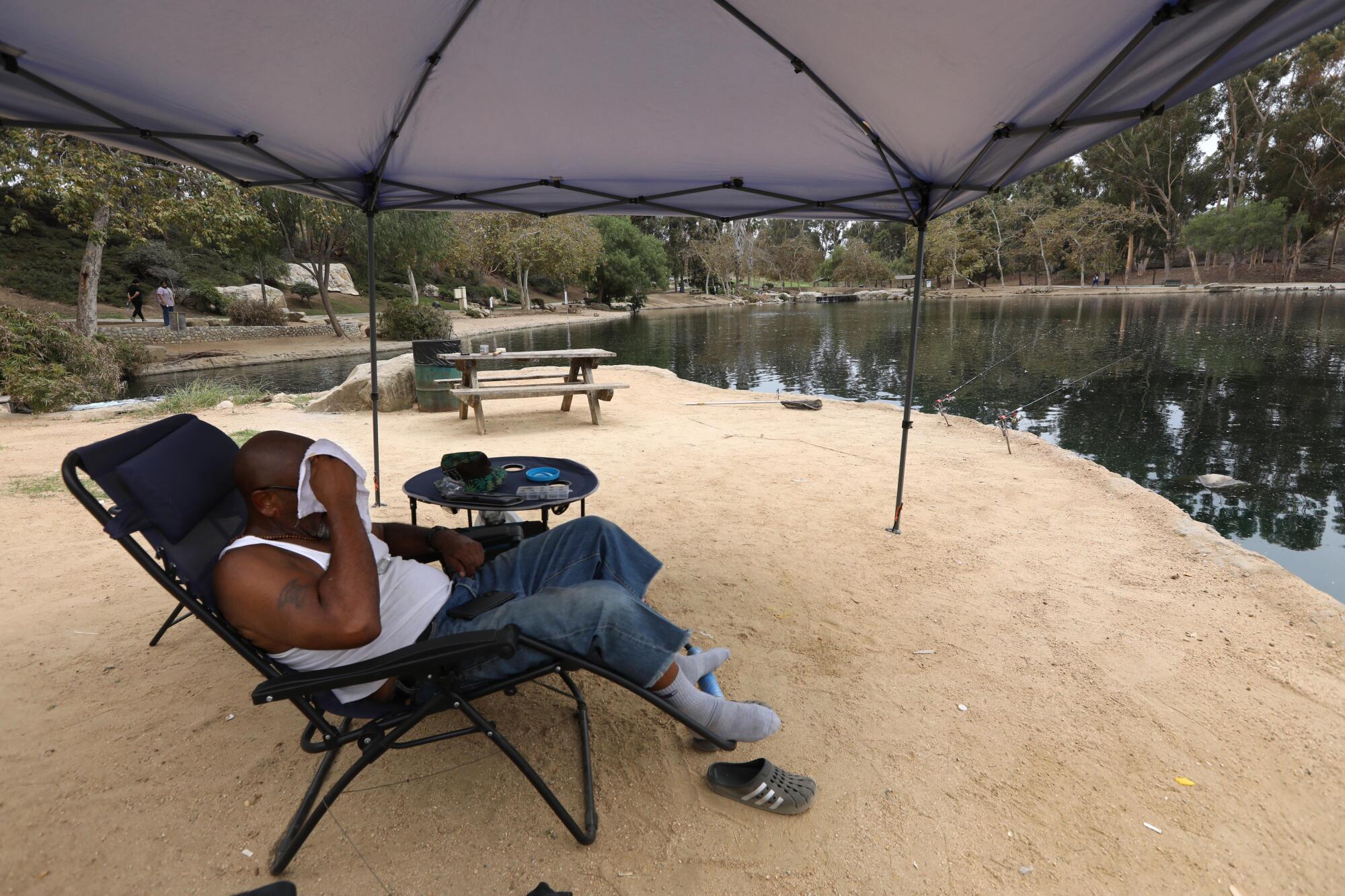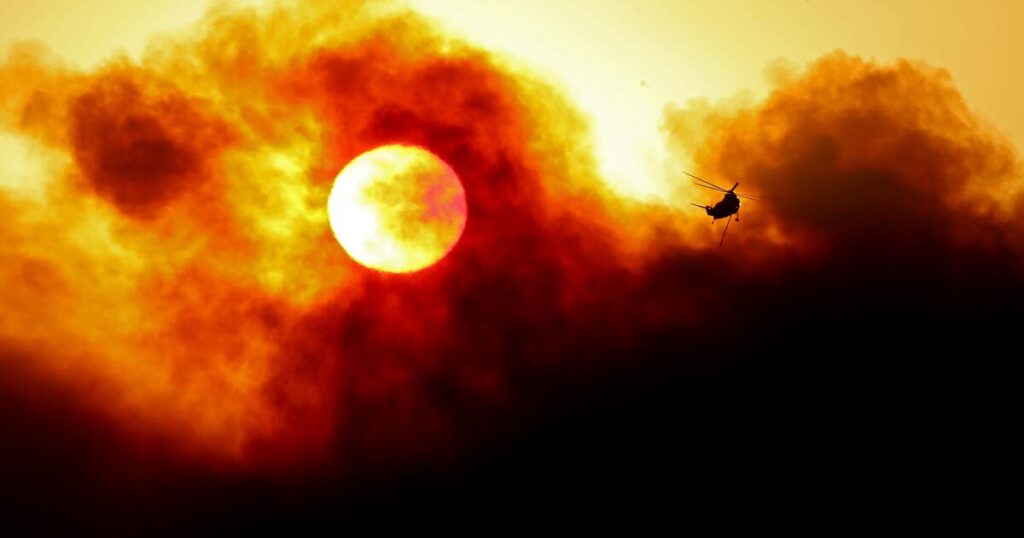The nation’s top emergency response agency has long been a lifeline for cities and states battling disasters. When hurricanes strike, earthquakes and tornadoes cause damage, FEMA steps in to provide critical resources and assistance.
Yet for all the help the Federal Emergency Management Agency is providing, its official definition of a “major disaster” does not include two threats that are increasingly harming millions of Americans: extreme heat and wildfire smoke.
In a rulemaking petition filed Monday, the Center for Biological Diversity and more than 30 other environmental groups, health care groups and unions argue it’s time to change the status quo. They’re asking for an amendment to the Stafford Act, FEMA’s animated regulation, to include extreme heat and wildfire smoke in its regulations.
Doing so, they say, will free up vital disaster relief funds, allowing local governments to invest in cooling centers and air filtration systems, work on resilient energy solutions like community solar and storage, and better prepare for emergencies.
“These twin climate-induced disasters now, year after year, far exceed the economic and technical capacity of state and local governments to manage, adapt, and mitigate further harm,” the petition states. “Federal action is necessary.”

Positive and impactful reporting on climate change, environment, health and science.
Currently, the Stafford Act defines a major disaster as “any natural disaster (including any hurricane, tornado, storm, high water, wind driven water, tidal waves, tsunami, earthquake, volcanic eruption, landslide, mudslide, blizzard or drought), or, for whatever reason, any fire, flood, or explosion in any part of the United States.
Lawyers for the Center for Biological Diversity argue the definition is broad enough to include heat and wildfire smoke, but agency officials have historically been hesitant to provide assistance in those situations because property damage and other material consequences can be harder to define.
In 2022, FEMA denied California’s request to declare a major disaster in response to a 10-day heat wave that killed 395 people in the state and stretched the power grid to its limits. In denying the application, the federal agency said “precedent is to assess discrete events and impacts, rather than seasonal or general atmospheric conditions,” according to the petition.

A Mesa, Arizona, resident enjoys cooler air in his home after fixing his air conditioner during the July 2023 heat wave.
(Ash Musings/The Age)
But the Stafford Act has been amended in the past, and FEMA is not afraid to use it in other emergencies, including the COVID-19 pandemic.
In 2020, then-President Trump approved a request to declare a COVID-19 major disaster to all states, tribes, and territories under the Stafford Act. President Biden subsequently approved similar requests from the Navajo Nation and the Poarch Band of Creek Indians and provided $3.46 billion in disaster mitigation funds to all areas that received a COVID-19 disaster declaration.
“The Biden and Trump administrations jointly acknowledge that infectious diseases constitute major disasters under the Stafford Act, although these events are not included in the definition of ‘major disaster,'” the petition states.
In this way, the federal government has accepted the explanation that there are major disasters beyond those enumerated in the definition, “so they have essentially accepted our argument,” said Sue Rang, a senior staff attorney at the Center for Biological Diversity. main author.
“So the question is why can’t FEMA take real action on extreme heat and wildfire smoke – which is the No. 1 killer of overall weather in the United States,” she said.
In fact, extreme heat is already taking a considerable toll on U.S. citizens, and its effects are only expected to worsen in the coming years as climate change and other factors cause global temperatures to rise further.
Over the past 30 years, extreme heat has killed more people than hurricanes, floods and tornadoes combined, with 2023 seeing the highest heat toll, according to the National Weather Service. Heat poses particular threats to children, pregnant women, older adults and people with underlying health conditions, as well as outdoor workers, low-income people and communities of color.
Last year, a record-breaking heat wave brought temperatures of 110 degrees or higher for 31 consecutive days in Phoenix, killing more than 600 people and causing a spike in heat-related illnesses and road burns. Su said the petition was born out of that incident.
Other signatories include the National Council on Occupational Safety and Health, Service Employees International Union and the United Farm Workers Foundation.

A man wipes sweat from his face while fishing under a canopy at Kenneth Hahn State Recreation Area in Los Angeles during a September 2022 heat wave.
(Genaro Molina/Los Angeles Times)
Will Humble, executive director of the Arizona Public Health Association, said he signed the petition because heat and smoke will continue to pose health risks to people, and “in both cases, state resources are sometimes insufficient to address these issues.” ”.
“Because of urban heat islands and climate change and the recalcitrance of these local jurisdictions, this is going to become more and more frequent, and I think there will be more and more times when we need significant federal resources,” he said.
Parts of the United States have already experienced extreme temperatures this year, with temperatures in Las Vegas and Phoenix reaching record highs, soaring to 111 degrees and 112 degrees respectively in early June. Severe heat waves are expected to blanket much of the Midwest and East Coast this week.
What’s more, West Coast forecasters have predicted a potentially active wildfire season due to hot and dry vegetation. So far this year, the California Department of Forestry and Fire Protection has responded to nearly 1,800 fires.
Along with these fires comes the danger of smoke—another harmful threat that can have fatal consequences. In fact, a recent study found that fine aerosols spewed by California wildfires between 2008 and 2018 caused as many as 55,700 premature deaths in the state.
Smoke from wildfires in California and elsewhere, including Canada, has spread far beyond the flames, with toxic particles reaching as far as the east coast of the United States and Europe. As fire activity increases in the coming years, so will the threat of smoke.
“Like extreme heat, smoke from wildfires is a natural hazard that is becoming more frequent and severe due to man-made climate change,” the petition states.
The costs of these hazards are also rising, with current and projected losses related to health care, agriculture, infrastructure repairs, workplace productivity and other outcomes reaching hundreds of billions of dollars, the petition states.
“When you combine the climate crisis with the severity and frequency of natural disasters … it’s non-stop,” said Kristin, communications director for the Worker Protection Project, a Texas-based advocacy group. Bolaños said the group experienced its largest wildfire on record earlier this year. “So we need some kind of federal regulation to help provide resources and support to these vulnerable communities.”
Bolaños said signing the petition was a “no-brainer,” especially given the disproportionate impact of heat, smoke and other hazards on immigrant workers and other high-risk groups.
“We definitely think that when there’s more support — and a focus on potential solutions at the federal level — then there’s hope at the state and local level, because some of these problems can only be solved when we work together rather than in silos,” she said explain.
Most of FEMA’s current resources come from disaster relief funds, which are allocated annually by Congress and can be carried over from year to year. Since 2020, the fund’s annual allocations have ranged from $20 billion to $70 billion. FEMA’s spending also fluctuates, reaching $69 billion in 2021, in part due to the pandemic, and just $19 billion in 2022.
“This is all a Congressional issue because extreme heat is really a bipartisan issue, and I hope Congress will take steps to actually help their states get funding for these extreme heat and wildfire smoke issues,” Sue said.
Amending the Stafford Act to include extreme heat and wildfire smoke would open new avenues for short- and long-term funding, the petition said. For example, short-term funding could provide temporary cooling centres, water stations and clean air centers that could be placed in urban cores or areas where workers suffer from extreme heat or smog.
But FEMA funding can also assist with long-term hazard reduction projects that not only help respond to disasters, but also prepare for them. These include permanent community recovery centers, air conditioning and filtration upgrades in public schools, or improved energy systems through rooftop solar and microgrids, which would also help people afford the electricity needed for cooling and filtration, Su said.
“This is a more innovative and proactive approach to emergency management that they as an agency are not accustomed to,” she said. “But just because you’re not used to it, doesn’t mean you don’t have the authority to do it and you shouldn’t do it.”
Su added that the broad statutory language in the Stafford Act already allows for such responses, as evidenced by actions during the COVID-19 pandemic. Formal changes to the bill’s language would require FEMA to initiate a rulemaking process in which experts could help develop and define clear thresholds and qualifications for heat and wildfire smoke particulate matter.
The petition is expected to receive widespread support from state and local leaders, she said.
Some are already pushing for FEMA to make changes through the bipartisan Extreme Heat Emergency Act, which similarly urges the agency to add extreme heat to its list of major disaster-qualifying events. The bill, introduced last year by Arizona Rep. Ruben Gallego, has been endorsed by officials in several states including Nevada, Texas and California.
Humble noted, however, that many of these issues do not exist in a vacuum and that cities and states also bear some responsibility for preparing for and responding to crises. In Phoenix, like California, housing shortages, homelessness and other challenges also expose more people to heat and smoke, he said.
“Preventing these heat-related deaths is really a state and local responsibility, but if we were to have FEMA — if FEMA were to do disaster response — It really should include extreme heat emergencies.
communication
Towards a more sustainable California
Get Boiling Point, our newsletter on climate change, energy and the environment, and become part of the conversation and solutions.
From time to time you may receive promotional content from the Los Angeles Times.

